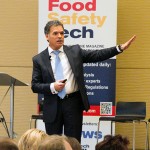Economically motivated adulteration (EMA) of food, or food fraud, has been estimated to cost the food industry $30–40 billion per year. The 2008 incident of melamine adulteration of milk powder has cost billions of dollars to companies and invaluable loss of consumer confidence. Even more significant than the economic cost or loss of confidence, the impact on public health was enormous. An estimated 290,000 consumers were affected with more than 50,000 hospitalizations including at least six deaths. There is also collateral damage caused by incidences of EMA, including the loss of confidence in government regulatory systems around food safety. Although major incidents like the melamine scandal happen infrequently, food fraud commonly occurs under the radar. According to a 2014 report by the Congressional Research Service, it is estimated that up to 10% of the food supply could be affected by food fraud Thus, the costs of fraud food are borne by industry, regulators and, ultimately, consumers.
Attend the Food Safety Supply Chain Conference, June 5–6, 2017 in Rockville, MD | LEARN MOREFood fraud is not a new phenomenon. During the time of the Roman Empire, Pliny the Elder wrote in Natural History about the adulteration of wine, bread and pepper, and tracked the fluctuation of their prices with the appearance of adulteration. In Medieval Germany, the adulteration of saffron was such a problem that the Safranschou Code was enacted, which described standards for saffron and allowed convicted adulterators to be executed.1 When there is an opportunity for economic gain, adulterators tend to come out of the woodwork.
As recently as the 1980s, food fraud was mostly an event confined to local markets. In 1981 the adulteration of olive oil with an industrial lubricant injured thousands and killed hundreds, but because the oil was not widely distributed, the primary effects were limited to Spain. Similarly, when apple juice adulteration occurred in the United States in the 1980s, the consequences were basically confined to the United States.
However, with the increasing globalization of the food supply chain and freer movement of foods and ingredients among countries, the opportunities for food fraud not only increased, but the consequences also now more easily have a global impact. By the late 1990s, the global consequences of food fraud became more evident with the contamination of fats intended for animal feed with industrial oils containing PCBs and dioxins. This scandal, which started with an oil recycler in Belgium, led to massive recalls of products throughout Europe and concerns about contaminated products reaching the United States. The impact of this episode arguably changed the food safety environment in Europe and led to the formation of the European Food Safety Authority. Likewise, the fallout from the adulteration of wheat gluten with melamine in 2008 likely contributed to the passage of new food safety legislation in the United States, including FSMA.
FDA has always acted against food fraud whenever there was an indication of public health hazards. With the passage of FSMA and the Preventive Controls for Human Food rule (published in September 2015), the agency has come full circle to its roots with Harvey W. Wiley, M.D. and his famous Poison Squad. Dr. Wiley formed his famous group to go after adulterators of foods. The Poison Squad was famously known for their willingness to consume suspect foods to test for adulteration. FDA’s history of Dr. Wiley states that “In the 1880s, when Wiley began his 50-year crusade for pure foods, America’s marketplace was flooded with poor, often harmful products. With almost no government controls, unscrupulous manufacturers tampered with products, substituting cheap ingredients for those represented on labels: Honey was diluted with glucose syrup; olive oil was made with cottonseed; and “soothing syrups” given to babies were laced with morphine. The country was ready for reform…” While the opportunities for fraud have not changed, luckily we no longer have to rely on human volunteers to detect adulterated food.
The new Preventive Controls rule published in September addresses EMA when there is a reasonable possibility that adulteration could result in a public health hazard. Companies are required to conduct a written hazard analysis, which should include hazards identification and evaluation. Companies are expected to identify “…known or reasonably foreseeable hazards that may be present in the food…The hazard may be intentionally introduced for the purposes of economic gain.”[i] While companies were previously expected to be knowledgeable about microbiological hazards in their products, it appears that they now also have the responsibility to be knowledgeable about known or reasonably foreseeable hazards from EMA.
How can organizations identify potential EMA threats as part of hazards analysis? One way is via the Food Fraud Database, which is designed to help answer this question by taking a look into the past. Launched in 2012, the database provides the information necessary to identify ingredients with a past pattern or history of adulteration and the adulterants used—a perfect fit for the EMA requirement in FSMA. The database has more than 140,000 users from 194 countries documented.
After identifying an ingredient with a pattern/history of EMA, companies need to determine whether the ingredient may introduce potential food safety hazards and how to develop a control plan in response. To address those issues, USP undertook a project in 2013 to take a more holistic approach to identifying EMA vulnerable ingredients by looking at factors beyond history. It assembled a group of leading food adulteration experts to develop a first-of-its-kind guidance document that offers a framework for the food industry to help develop and implement preventive management systems to deal specifically with EMA.
The Food Fraud Mitigation Guidance became official in the Food Chemicals Codex (FCC) in September 2015, just as FSMA’s Preventive Rule for Human Food was published. The aim of the guidance is to assist manufacturers and regulators with identifying the ingredients most vulnerable to fraud in their supply chains and how to choose effective mitigation tools to combat EMA. This is a significant leap forward in the battle against food fraud—and a way to get ahead of criminals engaging in EMA. The guidance provides not only a solution to deal with FSMA’s EMA provision, but goes beyond FSMA to help organizations fulfill GFSI requirements to conduct a food fraud vulnerability assessment and control plan.
Thenadier (The innkeeper), in Les Miserables said in the lyrics of Master of the House:
“…
watering the wine and making up the weight
…
Food beyond compare. Food beyond belief
Mix it in a mincer and pretend it’s beef
Kidney of a horse, liver of a cat
Filling up the sausages with this and that”
While deceiving the unwary can seem humorous in fiction, in real-life food fraud can have extremely serious consequences to consumers and everyone involved with the production of safe food. There are multiple large-scale efforts in many regions and countries to address food fraud. The attention that is now focused on food fraud and the development of new tools such as Food Fraud Database cast a bright light that will hopefully make it more difficult for food fraudsters to operate.
Reference
- Willard, P. (2002), Secrets of Saffron: The Vagabond Life of the World’s Most Seductive Spice, Beacon Press, ISBN 978-0-8070-5009-5








I´m sorry about my english, I have a question for you , our facility is certified in BRC Global Standard for 6 years, and now in this new 7th versión I ´m working in the vulnerability asessment of our raw materials. The question is , is there any other organization which has information about the food frauds that occurs in the world , because we need to be actualized in that information. We have based our firstanalysis on the USP food fraud information.
Thank you very much
Hi Verena,
We use the following:
US Pharmacopeial Convention (USP): https://www.foodfraud.org/
•US National Center for Food Protection and Defense (NCFPD): https://www.ncfpd.umn.edu/
•US Michigan State University: http://foodfraud.msu.edu/
•US Food and Drug Administration (FDA): http://www.fda.gov/Food/FoodDefense
•UK Food Standards Agency (FSA): http://www.food.gov.uk/enforcement/foodfraud
•UK Serious Fraud Office: http://www.sfo.gov.uk/fraud
•UK Food and Drink Federation (FDF): http://www.fdf.org.uk/corporate_pubs/Food-Authenticity-guide-2014.pdf